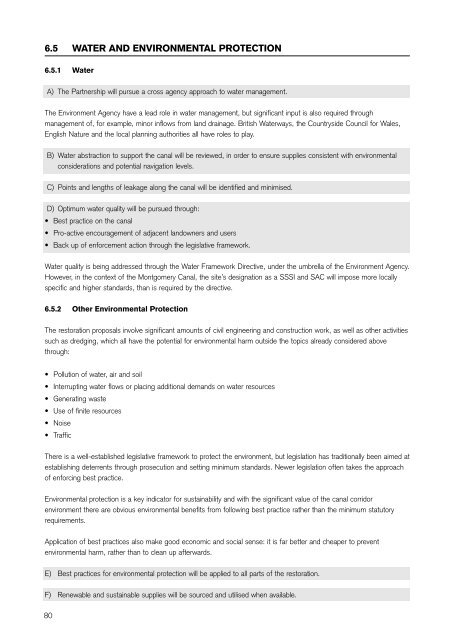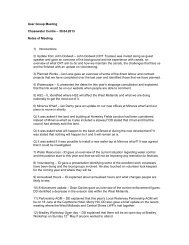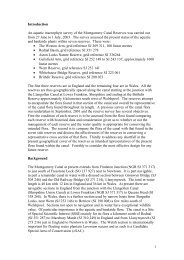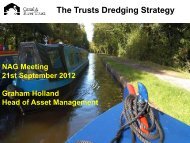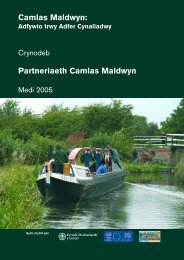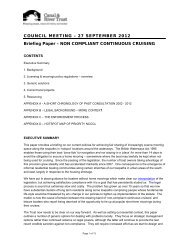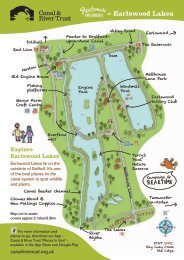Montgomery Canal Conservation Management Strategy (1.2MB PDF)
Montgomery Canal Conservation Management Strategy (1.2MB PDF)
Montgomery Canal Conservation Management Strategy (1.2MB PDF)
You also want an ePaper? Increase the reach of your titles
YUMPU automatically turns print PDFs into web optimized ePapers that Google loves.
6.5 WATER AND ENVIRONMENTAL PROTECTION<br />
6.5.1 Water<br />
A) The Partnership will pursue a cross agency approach to water management.<br />
The Environment Agency have a lead role in water management, but significant input is also required through<br />
management of, for example, minor inflows from land drainage. British Waterways, the Countryside Council for Wales,<br />
English Nature and the local planning authorities all have roles to play.<br />
B) Water abstraction to support the canal will be reviewed, in order to ensure supplies consistent with environmental<br />
considerations and potential navigation levels.<br />
C) Points and lengths of leakage along the canal will be identified and minimised.<br />
D) Optimum water quality will be pursued through:<br />
• Best practice on the canal<br />
• Pro-active encouragement of adjacent landowners and users<br />
• Back up of enforcement action through the legislative framework.<br />
Water quality is being addressed through the Water Framework Directive, under the umbrella of the Environment Agency.<br />
However, in the context of the <strong>Montgomery</strong> <strong>Canal</strong>, the site’s designation as a SSSI and SAC will impose more locally<br />
specific and higher standards, than is required by the directive.<br />
6.5.2 Other Environmental Protection<br />
The restoration proposals involve significant amounts of civil engineering and construction work, as well as other activities<br />
such as dredging, which all have the potential for environmental harm outside the topics already considered above<br />
through:<br />
• Pollution of water, air and soil<br />
• Interrupting water flows or placing additional demands on water resources<br />
• Generating waste<br />
• Use of finite resources<br />
• Noise<br />
• Traffic<br />
There is a well-established legislative framework to protect the environment, but legislation has traditionally been aimed at<br />
establishing deterrents through prosecution and setting minimum standards. Newer legislation often takes the approach<br />
of enforcing best practice.<br />
Environmental protection is a key indicator for sustainability and with the significant value of the canal corridor<br />
environment there are obvious environmental benefits from following best practice rather than the minimum statutory<br />
requirements.<br />
Application of best practices also make good economic and social sense: it is far better and cheaper to prevent<br />
environmental harm, rather than to clean up afterwards.<br />
E) Best practices for environmental protection will be applied to all parts of the restoration.<br />
F) Renewable and sustainable supplies will be sourced and utilised when available.<br />
80


